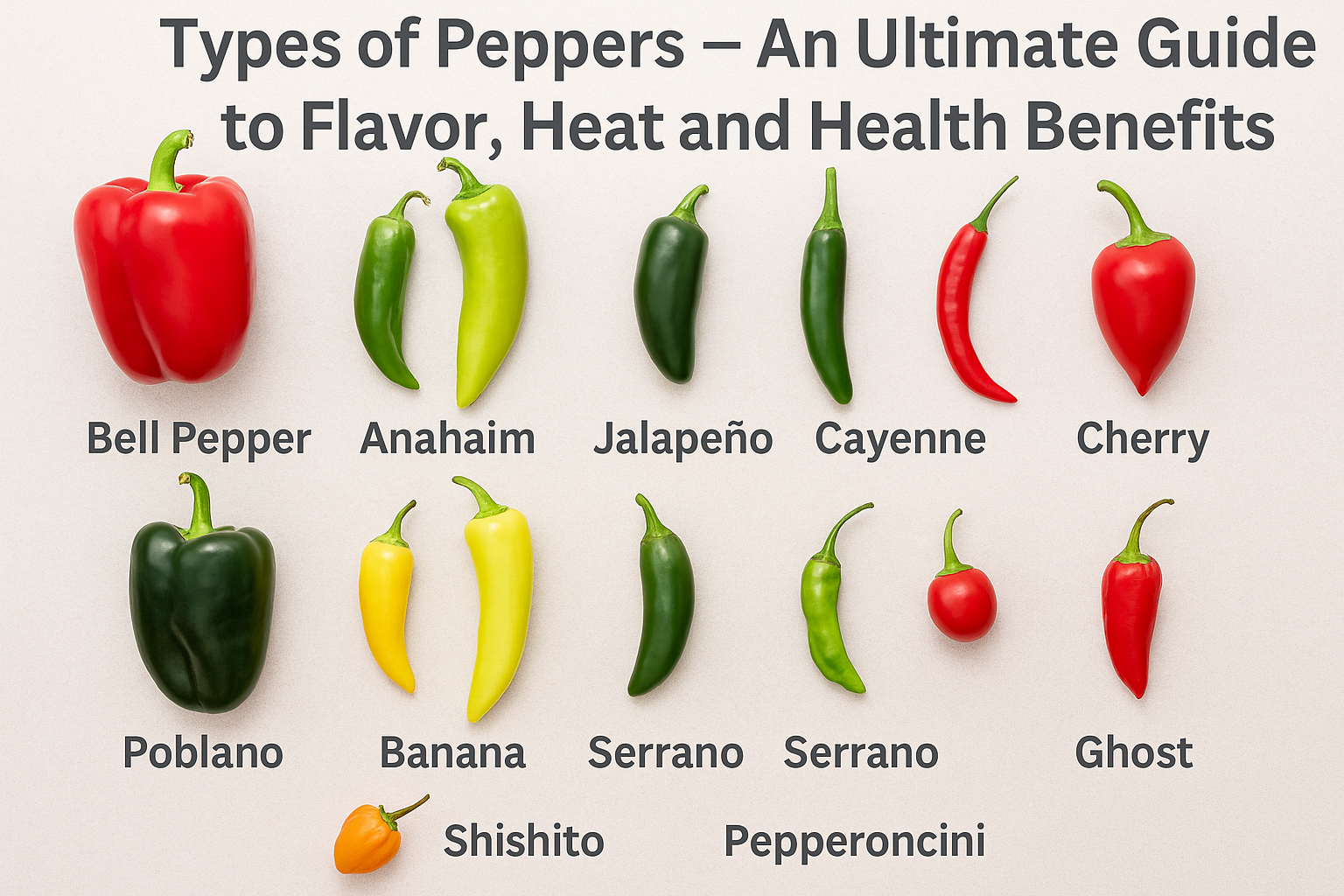Types of Peppers – An Ultimate Guide to Flavor, Heat and Health Benefits
Types of Peppers
Peppers are among the most fascinating plants in the world of cuisine. Originating in Central and South America, they’ve traveled across continents and cultures to become a cornerstone of global cooking. From the mild sweetness of banana peppers to the explosive fire of ghost peppers, these colorful fruits (yes – botanically they’re fruits!) offer an incredible range of flavors, aromas, and health benefits.
Understanding the different types of peppers helps you master your kitchen—balancing heat, color, and texture in any dish, while also appreciating their cultural, nutritional, and scientific background.
The Origins of Peppers: From the Andes to the World
All peppers belong to the genus Capsicum, part of the nightshade family (Solanaceae), which also includes tomatoes, potatoes, and eggplants.
Archaeological evidence shows that peppers were first cultivated over 6,000 years ago in Mexico and Peru. The indigenous civilizations—Maya, Inca, and Aztec—used them not only as food but also for medicine and rituals.
After Christopher Columbus brought peppers to Europe in the 15th century, they spread rapidly through trade routes to Africa, Asia, and the Mediterranean. Each region adapted them to local tastes: paprika in Hungary, piri-piri in Portugal, chili pastes in Thailand, and sambal in Indonesia.
Understanding the Scoville Scale
The Scoville Heat Unit (SHU) measures a pepper’s spiciness. Developed by pharmacist Wilbur Scoville in 1912, it quantifies the amount of capsaicin – the compound that activates pain receptors on your tongue.
Here’s a simplified scale:
| Category | Heat Level | SHU Range |
|---|---|---|
| Mild | Barely spicy | 0 – 2 000 |
| Medium | Noticeable warmth | 2 000 – 25 000 |
| Hot | Strong burning | 25 000 – 100 000 |
| Very Hot | Intense heat | 100 000 – 350 000 |
| Extreme | For experts only ! | 350 000 + SHU |
Note that the same variety can vary depending on climate, ripeness, and soil conditions.
Main Types of Peppers and Their Unique Traits
Chilli Pepper (Capsicum annuum)
The generic “chilli pepper” represents a large group of cultivars used in countless cuisines. Typically medium-hot, they provide a pleasant sting without overwhelming the palate.
Uses: Stir-fries, sauces, dried flakes, chili oil.
Fun fact: Dried and ground chilies are the base for chili powder blends worldwide.
Tabasco Pepper (Capsicum frutescens)
Small, slender, and pointed upward, Tabasco peppers are famed for their role in the iconic Louisiana hot sauce.
Heat: 30 000–50 000 SHU.
Flavor: Sharp, vinegary, and tangy.
Best for: Fermented sauces, seafood marinades, or spicy pickles.
Their juice-like consistency makes them ideal for liquid-based seasonings.
Banana Pepper (Capsicum annuum)
Named for its curved, yellow shape, the banana pepper is mild, with a subtle tang.
Heat: 0–500 SHU.
Taste: Sweet and slightly acidic.
Culinary use: Stuffed, pickled, or sliced into salads and sandwiches.
Because they’re low in capsaicin, they’re perfect for people who enjoy pepper flavor without the burn.
Rocoto Pepper (Capsicum pubescens)
Native to Peru and Bolivia, the rocoto thrives in cooler highlands.
Appearance: Apple-shaped with black seeds.
Heat: 30 000–100 000 SHU.
Taste: Fruity and juicy, with a crisp texture.
Culinary use: Essential in Peruvian “rocoto relleno”, a stuffed-pepper dish.
It’s one of the oldest cultivated peppers, genetically distinct with hairy leaves and thick walls.
Cherry Pepper (Capsicum annuum)
Round and bright red, cherry peppers have mild to moderate heat.
Flavor: Sweet, slightly smoky.
Use: Often pickled or stuffed with cheese, meat, or tuna; excellent for appetizers.
Their vibrant color makes them popular for antipasti platters.
Fresno Pepper (Capsicum annuum)
Developed in California in 1952, Fresno peppers resemble jalapeños but ripen to a richer red and fruitier taste.
Heat: 2 500–10 000 SHU.
Use: Mexican and South-American salsas, ceviches, and relishes.
They balance acidity beautifully and pair well with lime and tomato.
Serrano Pepper (Capsicum annuum)
Slim and crisp, Serrano peppers are about five times hotter than jalapeños.
Heat: 10 000–25 000 SHU.
Taste: Bright, green, and fresh.
Best used: Raw in guacamole or pico de gallo, or roasted for salsa verde.
Due to their thin skin, they’re less suited for drying but perfect for fresh recipes.
Ghost Pepper (Bhut Jolokia)
Originating from India, this pepper was the first to surpass one million SHU (1 041 427 to be exact !).
Heat: Extreme – use with caution !
Flavor: Smoky and earthy with a delayed, intense burn.
Uses: Tiny amounts in curries, chili con carne, or infused oils.
Safety tip: Always wear gloves when handling; keep away from eyes and skin.
Habanero Pepper (Capsicum chinense)
Famous in Caribbean and Yucatan cuisines.
Heat: 100 000–350 000 SHU.
Taste: Floral, tropical, reminiscent of mango and papaya.
Dishes: Jerk marinades, mango-habanero salsa, fruity hot sauces.
Its intense heat and aroma make it a favorite for balanced spicy-sweet recipes.
Poblano Pepper (Capsicum annuum)
Large, mild, and heart-shaped, poblanos are integral to Mexican cuisine.
Heat: 1 000–2 000 SHU.
Flavor: Rich, slightly smoky when roasted.
Use: Stuffed (“chiles rellenos”), soups, and moles.
When dried, they become Ancho chiles, used in many traditional sauces.
Cayenne Pepper (Capsicum annuum)
Slim and fiery red, cayenne peppers are dried and ground into the powder that bears their name.
Heat: 30 000–50 000 SHU.
Taste: Sharp and neutral – adds heat without changing flavor.
Use: Spicing soups, stews, meats, and detox drinks.
Cayenne is also used in natural medicine for boosting metabolism and circulation.
Bell Pepper (“King Oyster” type)
Technically a cultivar of Capsicum annuum, bell peppers are completely non-spicy (0 SHU).
Colors: Green (unripe), yellow, orange, and red (fully ripe).
Nutritional benefits: Extremely high in vitamin C and beta-carotene.
Use: Raw in salads, grilled, stuffed, or roasted for soups.
Their sweetness and color balance spicier varieties in mixed dishes.
Nutritional Profile and Health Benefits
Beyond their flavor, peppers are nutrient-dense superfoods.
- Vitamin C Powerhouse – Red bell peppers contain more vitamin C per gram than oranges, supporting immunity and skin health.
- Antioxidants and Carotenoids – Compounds like capsanthin and beta-carotene reduce oxidative stress and inflammation.
- Capsaicin Benefits – Found in spicy varieties, it may boost metabolism, reduce appetite, and promote fat oxidation.
- Pain Relief – Topical creams with capsaicin help with arthritis and nerve pain by desensitizing pain receptors.
- Heart Health – Regular pepper consumption can help lower LDL cholesterol and improve blood circulation.
- Eye Protection – Lutein and zeaxanthin from yellow/orange peppers help prevent macular degeneration.
In short, adding a rainbow of peppers to your diet not only brightens your plate but also nourishes your body.
Culinary Tips for Cooking with Peppers
- Adjust Heat Level: Remove seeds and white membranes to lessen spiciness.
- Balance Flavors: Pair hot peppers with sweet fruits (mango, pineapple) or acidic ingredients (lime, tomato).
- Roast and Peel: Grilling peppers enhances smoky notes and softens the skin for easier digestibility.
- Pickling: Preserves peppers for months while adding zing to sandwiches and tacos.
- Drying: Dried peppers develop complex flavors – try smoked paprika from pimentón de la Vera.
- Safety Tip: Wash hands with oil then soap after handling hot peppers – capsaicin is oil-soluble.
Growing Peppers at Home
Pepper plants are easy to grow and rewarding for home gardeners.
- Sunlight: At least 6–8 hours of full sun per day.
- Temperature: Prefer warm soil (>18 °C / 65 °F) and air temperatures around 25–30 °C (77–86 °F).
- Soil: Loose, well-draining with organic matter and slightly acidic pH (6.0–6.8).
- Watering: Consistent moisture without waterlogging. Mulching helps retain humidity.
- Fertilization: A balanced mix of nitrogen, phosphorus, and potassium; too much nitrogen can reduce fruiting.
- Harvesting: Pick when fully colored for maximum flavor and vitamins.
With proper care, a few plants can yield dozens of peppers each season.
Global Culinary Uses of Peppers
- Mexico: Fresh jalapeños and dried ancho for tacos and mole.
- Thailand: Bird’s-eye chilies in curries and som tam salad.
- India: Dried red chilies for tadka (oil tempering).
- Hungary: Sweet and smoked paprika define goulash.
- Italy: Crushed red pepper (peperoncino) adds kick to pasta.
- Caribbean: Scotch bonnet and habanero create fiery jerk seasonings.
Every culture transforms peppers into its own signature spice identity.
Fun Facts and Science
- Capsaicin and Endorphins: The burn triggers the brain to release endorphins, creating a natural “high.”
- Defense Mechanism: Capsaicin evolved to deter mammals but not birds – birds spread the seeds.
- Botanical Curiosity: Bell peppers are technically berries because they contain seeds inside fleshy fruit.
- Color Transformation: Green peppers are immature; they turn yellow, orange, then red as they ripen, gaining sweetness.
- Health Myth: Spicy food doesn’t cause ulcers – in fact, capsaicin can help kill H. pylori bacteria linked to ulcers.
Preservation and Storage Tips
- Refrigeration: Fresh peppers last 1–2 weeks in a ventilated bag.
- Freezing: Chop and freeze raw or roasted peppers for long-term use.
- Drying: Hang in a well-ventilated place or use a dehydrator for chili powder or flakes.
- Pickling: Combine vinegar, water, salt, and sugar for a tangy preserve that lasts months.
FAQ – Common Questions about Peppers
Q: Which pepper is the hottest in the world now?
A: Currently the Carolina Reaper (> 2.2 million SHU) holds the record, but new hybrids like Pepper X may surpass it.
Q: Can eating hot peppers improve metabolism ?
A: Yes, capsaicin stimulates thermogenesis, helping the body burn slightly more calories after meals.
Q: Are peppers safe for everyone ?
A: Generally yes, but people with acid reflux or sensitive stomachs should avoid very hot varieties.
Q: Do peppers lose vitamins when cooked ?
A: Some vitamin C is lost with heat, but roasting increases antioxidant bioavailability.
Q: What’s the difference between chili and paprika ?
A: Chili usually refers to hot varieties; paprika is made from sweet red peppers and is mild.
Final Thoughts
Peppers are more than just spice – they’re a symbol of diversity in nature and culture.
From the humble bell pepper to the fearsome ghost pepper, each variety tells a story of climate, soil, and human ingenuity. Learning to use them wisely lets you bring balance, color, and vitality to your meals. So next time you reach for a pepper, remember: you’re holding thousands of years of culinary history and science in your hands


0 Comment